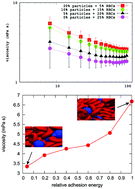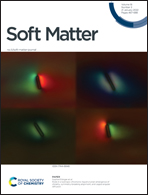The effect of rigid cells on blood viscosity: linking rheology and sickle cell anemia†
Abstract
Sickle cell anemia (SCA) is a disease that affects red blood cells (RBCs). Healthy RBCs are highly deformable objects that under flow can penetrate blood capillaries smaller than their typical size. In SCA there is an impaired deformability of some cells, which are much stiffer and with a different shape than healthy cells, and thereby affect regular blood flow. It is known that blood from patients with SCA has a higher viscosity than normal blood. However, it is unclear how the rigidity of cells is related to the viscosity of blood, in part because SCA patients are often treated with transfusions of variable amounts of normal RBCs and only a fraction of cells will be stiff. Here, we report systematic experimental measurements of the viscosity of a suspension varying the fraction of rigid particles within a suspension of healthy cells. We also perform systematic numerical simulations of a similar mixed suspension of soft RBCs, rigid particles, and their hydrodynamic interactions. Our results show that there is a rheological signature within blood viscosity to clearly identify the fraction of rigidified cells among healthy deformable cells down to a 5% volume fraction of rigidified cells. Although aggregation of RBCs is known to affect blood rheology at low shear rates, and our simulations mimic this effect via an adhesion potential, we show that such adhesion, or aggregation, is unlikely to provide a physical rationalization for the viscosity increase observed in the experiments at moderate shear rates due to rigidified cells. Through numerical simulations, we also highlight that most of the viscosity increase of the suspension is due to the rigidity of the particles rather than their sickled or spherical shape. Our results are relevant to better characterize SCA, provide useful insights relevant to rheological consequences of blood transfusions, and, more generally, extend to the rheology of mixed suspensions having particles with different rigidities, as well as offering possibilities for developments in the field of soft material composites.



 Please wait while we load your content...
Please wait while we load your content...
